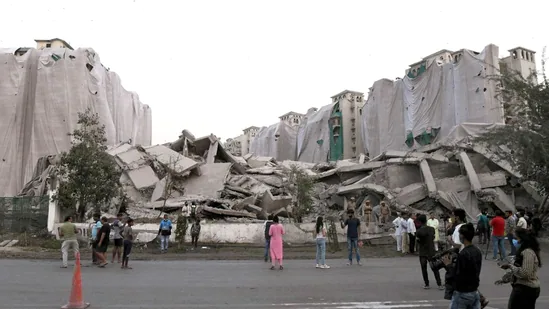Noida twin towers’ explosion causes no major damage to nearby societies
Although no major damage happened to either Emerald Court or ATS Village – the nearby societies -, a compound wall of ATS suffered a crack due to the demolition.

Residents of nearby housing societies of Supertech twin towers heaved a sigh of relief on Sunday after officials confirmed that there appeared no major damage to the buildings following the demolition of the structures.
Emerald Court and ATS Village are the nearest societies of the twin towers, and nearly 5,000 residents were vacated earlier in the day ahead of the demolition as per the Noida Authority’s evacuation plan.
Residents of the Emerald Court said they moved to different locations, including one going to New Delhi, before the demolition happened. One resident Ekta Gupta said they were provided accommodation at a nearby society, and is “relieved to know” there is no damage to their building.
Despite the clearance after the Supreme Court-mandated demolition of the Supertech twin towers, officials stressed that a more detailed audit is underway.
Although no major damage was done to any of the two housing societies, a compound wall of ATS Village suffered a crack owing to some concrete pieces shooting to its direction during the demolition.
Both Noida Authority CEO Ritu Maheshwari and engineer of Edifice Engineering – the Mumbai-based firm tasked with the demolition – Chetan Dutta, confirmed the crack.
“10 metres of the boundary wall of a nearby society, ATS has been damaged after being hit by the debris. No information of damage from anywhere other than this has been received,” Maheshwari was quoted as saying by ANI.
Meanwhile, Central Building Research Institute (CBRI) senior principal scientist DP Kanungo told PTI that window panes of several nearby flats of both Court and ATS Village suffered cracks.
A Gas Authority of India Limited (GAIL) pipeline that runs through the now-demolished Supertech twin towers survived the blast and is safe, officials added.
“The GAIL pipeline is safe. Iron sheets measuring 5 by 5 metres were placed above the pipeline at two locations. Besides, several tyres were also placed on top of them to absorb debris shock,” Kanungo said.
The controlled blast of the 100-metre tall twin structures – taller than Delhi’s Qutub Minar – were brought down by the ‘waterfall implosion’ technique in a matter of 9-10 seconds. The Noida Authority and city police had taken extensive preparations ahead of the process, with essential vehicles such as fire tenders and ambulances on standby. The Noida-Greater Noida Expressway was also shut for nearly an hour to keep the demolition site traffic free.
Edifice had hired South Africa’s Jet Demolitions for its expertise for the demolition, while the CBRI was appointed by the Supreme Court as a technical expert for the project. The demolition saw the end of a nine-year legal battle.



